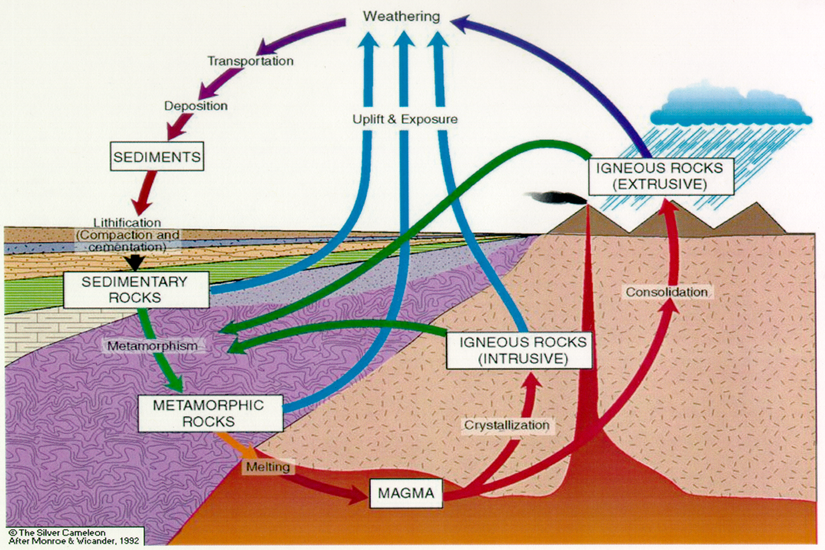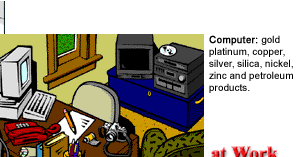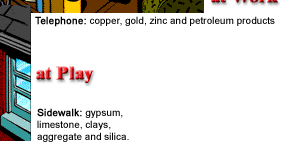| HOME | KIDSROCK | TEENSROCK | GEOTOURS |

| Origins of Rock |
Rock Lore | Manitoba... rocks! |
EARTHWise | Geo-Gallery | DownLodes | Fun Zone | Rock Talk | Geo-Words | Geo-Links | Explore Manitoba |
Where do rocks come from?
If you could picture the earth as a gigantic house with a foundation made up of many different types of rocks, what would that foundation look like? Think about it...some rocks form the outline of hills and mountains, others are found below rivers, fields, plains, valleys, and oceans. Any way you look at it, rocks are everywhere!
The Rock Cycle
Rocks are all around us. Did you know the Earth has a floor? The floor is made of rocks and the rocks change in cycles, commonly referred to as the Rock Cycle (see Figure 1 below). Rocks are divided into three basic types depending on how they were formed: igneous, sedimentary and metamorphic. Plate tectonics provides an explanation for how rocks are recycled from igneous to sedimentary to metamorphic and back to igneous again.
Igneous rocks: Deep in the earth's crust there are places where the rock has melted into magma which is a mixture of crystals and liquid rock. Sometimes the magma erupts out of the earth through a volcano and then it is called lava. When the lava cools and hardens on the earth's surface, it is called volcanic igneous rock. If the magma cools and hardens under the ground, it is called plutonic igneous rock.
Sedimentary rock: Wind and water cause erosion, breaking off pieces of rock and carrying them from one place to another. Gradually these pieces along with sand, pebbles, shells and plant matter gather into layers called sediment. Over a long period of time the sediment hardens into rock. That is how sedimentary rock is formed. Most of the rock on the earth's surface is sedimentary.
Metamorphic rock: Just as cookie dough changes as it is baked, rock changes as it is heated, squeezed or both. Rocks deep within the earth are put through intense heat and pressure. In time, these forces change sedimentary or igneous rock into another type of rock called metamorphic rock.

Download a fact sheet about the Rock Cycle. ![]()
Rocks are everywhere
Many of the minerals derived from rocks are used in hundreds of products we use. And many of the everyday products we depend on using wouldn’t exist without rocks and minerals. Need proof? Have a look at this image and see how rocks are in almost everything around you. Remember, if it can't be grown, it has to be mined!
 |
 |
 |
 |
 |
 |
Need more examples? If you brushed your teeth this morning, you brushed your teeth with rocks! Study the birth of the bicycle to find out why rocks are important to help you get around. Even cyberspace and rocks have things in common. Learn why famous Canadian activities like ice-skating and hockey would be lost without rocks and minerals. Planning on going somewhere? Discover how we wouldn’t get very far on the roads we travel...without rocks! As you can guess, rocks, geology, and mining together play in an important part in our society. Find out more about the mining industry in Manitoba, or take a trip through Manitoba's rich mining history.
Geo-Detectives
If you looked at a rock and wanted to figure out how it was formed, you might feel like a detective searching for clues. That’s what a geologist does. Geologists study the earth to understand the origins of rock. A geologist carefully examines rocks for evidence about how old the rock is and what it might be made of, and will look at the shapes of the grains or crystals within the rock, and how the grains or crystals fit together. This can all provide valuable clues to help a geologist unlock the rock's hidden history.
As a geo-detective, you would also explore time the way a geologist does --- not in seconds or minutes or hours, but in eons, eras and periods. Look at this geologic time chart below. Can you find the geologic period where humans showed up?

Chart appears courtesy of Library and Archives Canada
Canada Rocks!
From northern lights to urban trails, Canada is one of the world’s largest mining nations producing over 70 minerals, metals, and their products. Canada is one of the world’s top five producers of such mineral commodities as uranium, potash, aluminum, diamonds, zinc, gypsum, molybdenum, platinum group metals (a group of six rare metallic elements), salt, cadmium, titanium concentrate, and asbestos.
